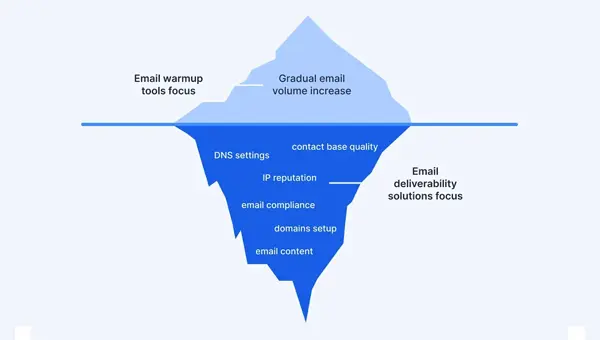If you’ve ever sent out a perfectly crafted email campaign only to be met with silence, you’re not alone.
Chances are, your emails never even made it to the inbox. That’s where a solid warmup strategy – also known as domain warming or email domain warmup, becomes essential.
Whether you’re using a brand-new domain or reviving one that’s been dormant, skipping the warmup process can crush your email deliverability. But don’t worry, this guide will show you how to warm up your domain effectively and avoid the spam folder trap.
What Is Email Warmup, Really?

Think of domain warming like a first impression. When you show up at someone’s inbox out of nowhere. especially from a new email domain, inbox providers like Gmail or Yahoo get cautious. They don’t yet trust you.
Domain warming is the process of gradually building that trust by starting small, sending to engaged subscribers, and steadily increasing volume over time. You’re telling ISPs (Internet Service Providers):
“We’re a legitimate sender who follows email best practices, not a spammer.”
Why Warming Up Your Domain Matters
If your emails don’t land in the inbox, none of your effort matters. Here’s how email domain warm up helps:
✅ Boosts Inbox Placement
Your messages are more likely to reach the inbox instead of the spam folder.
✅ Builds Sender Reputation
A strong sender reputation signals to inbox providers that you’re a trusted communicator.
✅ Protects Domain Health
Avoids high bounce rates, spam complaints, and blacklists.
✅ Improves Engagement
More emails delivered = more opens, clicks, and conversions.
In short, warming up your domain is the foundation of email deliverability and long-term email marketing campaign success.
How to Warm Up an Email Domain

Warming up a domain isn’t hard, but it must be done right. Here’s how to warm up your domain step by step:
✅ Start with a Small Audience
Begin with 50–100 emails per day. Target your most active users, those who are likely to open, click, or reply.
✅ Gradually Increase Your Volume
Over 2–4 weeks, slowly increase your email volume. This signals to inbox providers that you’re growing responsibly, not blasting spam.
✅ Set Up Proper Email Authentication
Before sending anything, set up SPF, DKIM, and DMARC. These email authentication protocols confirm that your emails are legitimate and help prevent spoofing.
✅ Stay Consistent
Avoid erratic sending. Stick to a steady schedule and similar sending patterns. Inconsistency can hurt your sender reputation.
✅ Monitor Key Metrics
Track bounce rates, open rates, and click-through rates. If engagement drops, slow down your sending and troubleshoot.
Can’t I Just Send Emails and Hope for the Best?
Short answer: not if you care about email deliverability.
We’ve seen it too often: marketers launch large-scale campaigns from a new domain without warming up. The result?
Spam folders, blocked emails, and damaged sender reputation.
Once your domain is flagged, recovery can be difficult and time-consuming. That’s why warming up your domain isn’t optional, it’s essential.
Avoid These Common Domain Warm Up Mistakes
❌ Sending to a cold or purchased list
❌ Skipping email authentication setup
❌ Increasing send volume too fast
❌ Ignoring performance metrics like open rate and bounce rate
Think of it like warming up before a workout, it prevents injury, or in this case, poor inbox placement.
Final Thoughts: Why Domain Warming Pays Off
Warming up your email domain may seem like a small detail, but it has a massive impact. It’s the difference between hitting spam folders and reaching your audience’s inbox consistently.
When you take the time to build trust with inbox providers, you’re investing in long-term email marketing success, higher engagement, better deliverability, and stronger customer relationships. Start your next email campaign on the right foot.
Let cmercury help you warm up your domain the smart way, so you can focus on what really matters: sending emails your audience loves.
Disclaimer: This blog post was created with the assistance of Human Content Creators, AI and Search tools to help collect information, plan content, and ensure accuracy. We strive to deliver valuable and well-researched insights to our readers.
